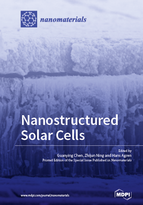Nanostructured Solar Cells
A special issue of Nanomaterials (ISSN 2079-4991).
Deadline for manuscript submissions: closed (31 March 2016) | Viewed by 115043
Special Issue Editors
Interests: lanthanide; crystals and nanocrystals; nonlinear; biophotonics; solar cells
Special Issues, Collections and Topics in MDPI journals
Interests: theorectial chemistry; quantum-classical modelling; light-matter interaction; spectroscopy; nanobiotechnology; plasmonic and upconverting nanoparticles
Special Issue Information
Dear Colleagues,
Solar cells are generally regarded as a promising renewable energy source. Though significant progress has been made in recent decades, a complete replacement of traditional energy sources by solar cells still requires improvement in device performance. Recently, the emerging use of nanostructures by newly developed nanotechnology provides opportunities to significantly enhance the efficiency by plasmonic enhancement, reflection enhancement, light scattering, and enhanced carriers collection efficiency, among other attributes. On the other hand, numerous kinds of solar cells, such as perovskite solar cells, colloidal quantum dot solar cells, organic heterojunction solar cells, dye sensitized solar cells have been developed. The combination of solution processed solar cells and nanostructures, leads to a much improved performance of devices. One reason for this is that nanostructures enable significantly enhanced light harvesting in the near infrared or infrared region, where most active materials have poor light absorption capacity. Additionally, the use of nanostructures can lead to enhanced carriers collection efficiency and photocurrent generation.
This Special Issue will present comprehensive research outlining progress on the application of nanostructures to improve the performance of solar cells. This includes the utilization of plasmonic, light reflection or light scattering enhancement to improve light absorption and the construction of new kinds of device structures to improve carriers’ collection. We invite authors to contribute original research articles and review articles covering the current progress on nanostructured solar cells. Potential topics include, but are not limited to:
1. Colloidal quantum dot solar cells based on nanostructured devices.
2. Dyes or colloidal quantum dot sensitized solar cells based on nanostructured electrodes.
3. Perovskite solar cells based on nanostructures.
4. Organic polymer heterojunction solar cells by plasmonic enhancement.
5. Small molecular heterojunction solar cells with nanostructures.
6. Thin film solar cells including amorphous silicon, copper indium gallium selenide solar cells (CuInGaSe), cadmium telluride solar cells based on nanostructures.
7. Nanostructured crystalline silicon solar cells.
Prof. Dr. Guanying Chen
Dr. Zhijun Ning
Prof. Dr. Hans Agren
Guest Editors
Manuscript Submission Information
Manuscripts should be submitted online at www.mdpi.com by registering and logging in to this website. Once you are registered, click here to go to the submission form. Manuscripts can be submitted until the deadline. All submissions that pass pre-check are peer-reviewed. Accepted papers will be published continuously in the journal (as soon as accepted) and will be listed together on the special issue website. Research articles, review articles as well as short communications are invited. For planned papers, a title and short abstract (about 100 words) can be sent to the Editorial Office for announcement on this website.
Submitted manuscripts should not have been published previously, nor be under consideration for publication elsewhere (except conference proceedings papers). All manuscripts are thoroughly refereed through a single-blind peer-review process. A guide for authors and other relevant information for submission of manuscripts is available on the Instructions for Authors page. Nanomaterials is an international peer-reviewed open access semimonthly journal published by MDPI.
Please visit the Instructions for Authors page before submitting a manuscript. The Article Processing Charge (APC) for publication in this open access journal is 2900 CHF (Swiss Francs). Submitted papers should be well formatted and use good English. Authors may use MDPI's English editing service prior to publication or during author revisions.
Keywords
- Photovolatics
- solar cells
- nanomaterials
- nanostructures
- light harvesting
- light management
- plasmonic
- interface engineering
- carrier multiplication








